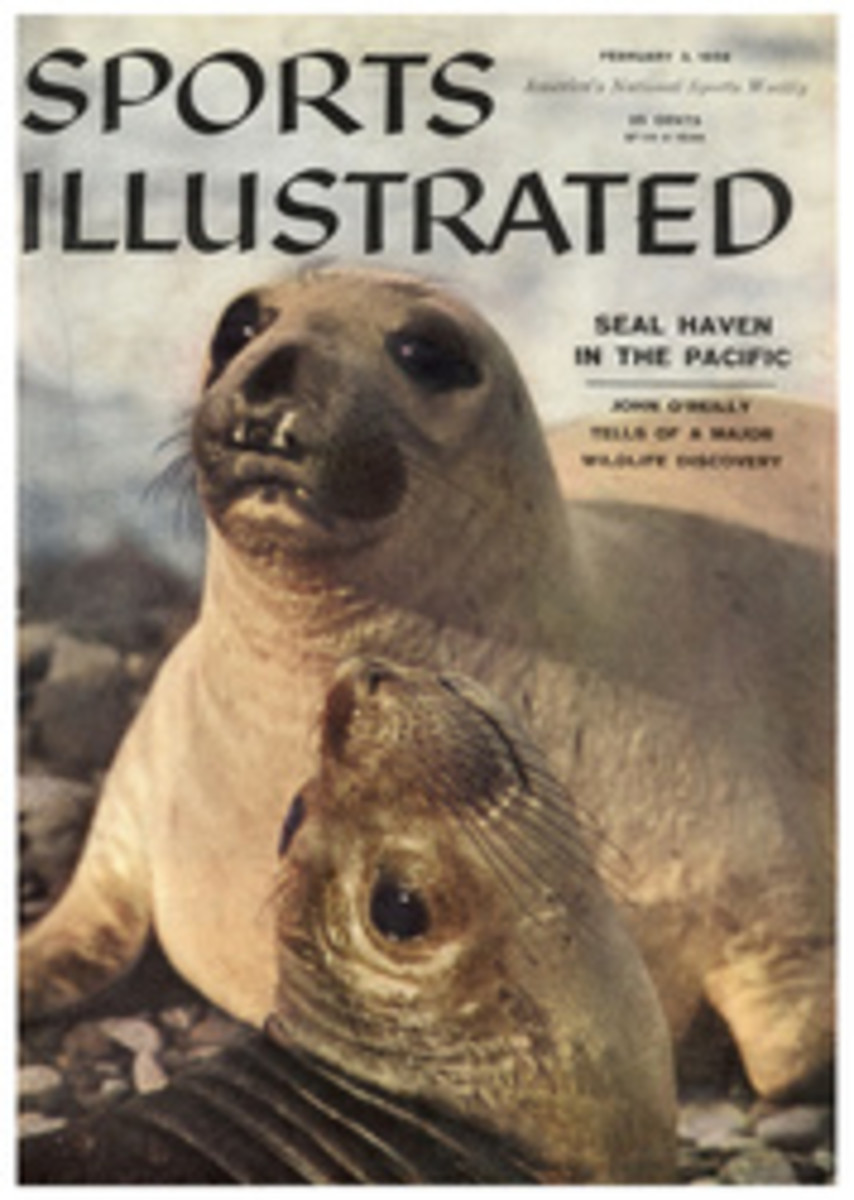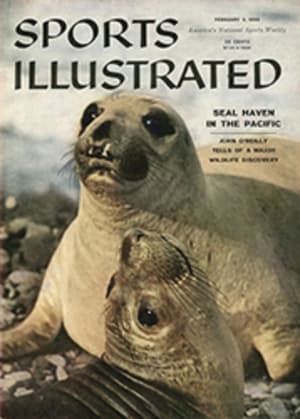
Finding a Golfer Named Goosie
In the middle of the first round when there were still over 150 golfers at large on the sprawling fairways and rolling greens of the club deportivo Campestre de Tijuana, a perplexed-looking wire service reporter was seen hurrying out to the center of the action, notebook in hand. "I gotta go find a golfer named J. C. Goosie," he explained. "Knoxville wants special coverage on him. Ever heard of him?"
Three days later, when the scores for the $17,000 Caliente Open were posted, not only the Associated Press clients in Knoxville, but most of the rest of the golf world had heard of J. C. Goosie. J. C. (which initials he adamantly refuses to elaborate on) is the happy-go-lucky young (28) man who very nearly stood the cream of America's golf professionals on their ears in the third revival of the Tijuana tourney, event No. 3 on the 1958 winter tour.
Co-leader at the end of three rounds (with 208), young Goosie, a handsome, bronzed youngster with a perpetual twinkle in gray-blue eyes, was playing par golf with three holes left in the final round and had only to par in for first place. He had been playing faultless golf from tee to green, consistently outdriving his playing partners, Gene Littler and Fred Hawkins. But he had been coming up short with six-foot putts, a sure indication the dread last-round yips were having their effect.
The 16th is a horrendous elliptical golf hole at Tijuana, uphill all the way and listed on the card at 425 yards but playing at least 50 further in the Caliente tournament. The tee was stuck down in a hollow at one end of the ellipse and the pin buried in the narrow turkey neck of a green barely five club lengths wide at the other. Goosie drove well to start the long uphill fight, but groaned aloud as he spotted the delicate location of the flag. "Sure looks like a rough golf hole today," he murmured to Littler as he snapped a five-iron out of his bag.
A presumptuous shot
It was what it looked. Goosie's five-iron, hit a bit too hastily, was pulled a bit left, not enough off line to give trouble on most greens but disastrously off for this one. It was a typical Goosie shot—bold, presumptuous and aimed for the pin rather than the safe, swollen front edge of the green. But it landed on a sidehill almost hole-high and across a culvert from the strictured green. A small rock kept the ball from sliding down to the bottom of the ditch. Goosie swung quickly at this hanging lie before the rock could move and let the ball roll into deeper trouble. The ball squirted across the green and climbed the grassy hill on the other side. With one foot in the air and his putter held like a window-washer trying to scrape water off a pane of glass, Goosie tried to rake the ball down to the hole. It stopped two and a half feet short. When he missed even that, for a double bogey, it was clear that Goosie was cooked.
Yet when he not only came up smiling but walked away to birdie the next hole, it was also clear that J. C. will be heard from again. As it turned out, that amiable, ambling Ozark, Ernest Joe (Dutch) Harrison, won the tournament, his umpteenth in a career which has seen him come from a plantation worker's son in Arkansas to golf's ninth alltime money winner ($154,000). Dutch was almost the most surprised man on the course when he was presented with the check. "All I was tryin' to do was beat those two fellas [Jerry Barber and Bo Wininger] I was playin' with. Lord knows, that was tough enough [they both tied for second]."
In general, it was that kind of up-and-down tournament. It began with Wininger and the San Francisco kewpie doll Bob Rosburg, flying 65s from the first-round scoreboard. When Wininger matched that with a 69 the second day, it seemed about over. But he fell all the way downstairs with a shaggy 77 the third day.
Meanwhile, Rosburg clubbed his way steadily along in second place until the third round, when he fell over retrieving his ball on the 5th green and threw his back out of place. Under pain, he was forced to lunge at the ball like an overanxious rookie swinging—at the last minute—at a three-and-one pitch outside and low. When the tour supervisor Harvey Raynor was explaining this to Pro Jim Ferrier with gestures, Ferrier stopped short while pulling a sweater over his head and looked at Raynor in amazement. "But that's the way he swings all the time anyway!" he protested.
Harrison owed his good luck as much to the collapse of Stan Leonard as to Goosie's double bogey. Like Goosie, Leonard, who should have known better, played too daringly for a man who had a stroke lead going into the final round. He cut an approach too fine at No. 5 and rapped a ball out of bounds on No. 7 to be well out of it before he hit the back nine the final day.
Since it was held in Old Mexico, the tournament posed some unaccustomed hazards for the touring pros. The Mexicans, who are caricatured as somnolent, are anything but when they get behind the wheel of a car, and the pros who had to play the holes bordering the highways did so with knees shaking. Many a golf shot was attempted by a player looking nervously over both shoulders at once. It was not their lives that were in danger, just their nerves. A Tijuanan believes it is unmanly to use the brakes on a car when the horn will serve as well—or almost as well. The horns of Mexico spoiled more drives than a choppy backswing, and a fast action camera would surely have caught more than one pro swinging at the ball in the middle of a full nervous wince, eyes closed tightly and shoulders hunched in a spasm. Once a rickety truck, vintage of John Steinbeck's Grapes of Wrath, was rattling along the road which bordered the 18th fairway as Pro Frank Stranahan was addressing his approach shot. The driver, sombreroed, was going full throttle when he spotted Stranahan. He brought his crate to an immediate stop with a spine-tingling squeal of tires and simultaneous honking of the horn. The driver was equal to the strain, but the tires were not, and one of them gave up the ghost with aloud report—at which point Stranahan jumped at the ball like a man under whom a firecracker has just been detonated, and the result was a slithered shot which spurted up to the wrong side of the green. Stranahan glared, but the driver grinned back at him sunnily. He didn't mind the tire at all.
The Mexicans were in the decided minority in most of the golf galleries throughout the tournament. When the races were running at nearby Caliente track they ignored the golf altogether. Golfers are too unpredictable to bet on, they have found out, and even a quinella on Hogan and Snead would have been spurned by the same people who pick a horse by pointing at a program while covering their eyes. Even before the Caliente Calcutta was discontinued at the suggestion of the PGA, it was never a big betting feature for Ti-juanans and was abandoned this year without a regretful look.
The pros, for their part, missed a good part of the charm of Old Mexico—as they so often miss the charm of the places they happen to be invading for money. Most of them, wisely if un-gallantly, chose to stay in motels across the border in nearby Chula Vista Calif. This is because the water in Tijuana is as unpredictable as a wood shot from the deep rough. The pros, unromantic about any geography they don't have to putt on anyway, felt it was wiser, since it would be tough to keep up with one's threesome in the throes of an attack of the dread turista.
The pros, also characteristically, ducked a cocktail party and buffet in their honor—a bit of thoughtlessness that American sponsors have long since grown accustomed to but which seemed inexplicable to the gracious Mexican officials. Growled one guest:
"Walter Hagen made a big pitch to get the golf pros in the front doors wherever they went. But you wonder why he bothered. These guys couldn't care less."
Not all the natives were offended at the lack of the festive spirit in the ranks of the golfers. The caddies, for instance, understood perfectly. One of them, as soon as he was paid off by Al Besselink, dropped the golf bag then and there and began hawking sunglasses. Besselink packed his own sticks to the clubhouse. Another small boy, struck by a shot of Art Wall's, climbed over a fence and resentfully refused to surrender the ball. It had hit him, hadn't it? was his attitude. One caddie shushed his golfer on one green near the race track when a call was coming over the loudspeaker. "I got a horse going," he explained.
But over-all there was a charm and gentility which was peculiarly Mexican to the whole occasion. Waiters and police were unfailingly polite and a cordon of police would form for any visiting galleryite who wanted to cross the teeming highway at the front of the club. The food was outrageously good, and at night the pleasant sound of music from a thousand homes filled the soft air. No home or even hovel was without it, it seemed.
Frowning golfers
It seemed also, in some ways, a shame to have to putt for a living in such a gracious and leisurely atmosphere. The golfers were almost the only human beings around wearing a frown, a characteristic which finally began to irritate a young lady on the 18th green who wanted to leave for more festive things while her escort wanted to watch the golf. As threesome after threesome, all wearing the preoccupied tight-lipped look of the man who is going about a nasty and serious business, came up on the green, her irritation finally outgrew its restraint. "What do you want to stay and watch these golfers for?" she demanded. "You've seen one, you've seen 'em all."
But, it happened, not quite all. For old Dutch, who always had time to stop and chat on the way through his final, climactic 69, played with the relaxation of a man on a weekend round with his best friend. He rooted his opponents' shots into the hole, addressed everyone as "Mister" and seemed almost distressed that he had won. Nearly 48 (in March), and a grandfather, he opined he just hoped to play out one more year and the only reason he was touring was because he wanted to go out a winner. "If I could do real good this year, I'll go out," promised Dutch. "I don't think I can see too good any more, not as well as I used to anyway." It was the consensus of 150 of Dutch's competitors at Tijuana that Dutch could see quite well enough. About one shot per round too well, in fact. "I never saw him miss one of those holes in the center of the green anyway," grinned Jerry Barber.
PHOTO
ARKANSAS TRAVELER is nickname for Dutch Harrison, amiable Caliente winner.
PHOTO
TENNESSEE TYRO is J. C. Goosie, who almost won his first big-time tournament.

